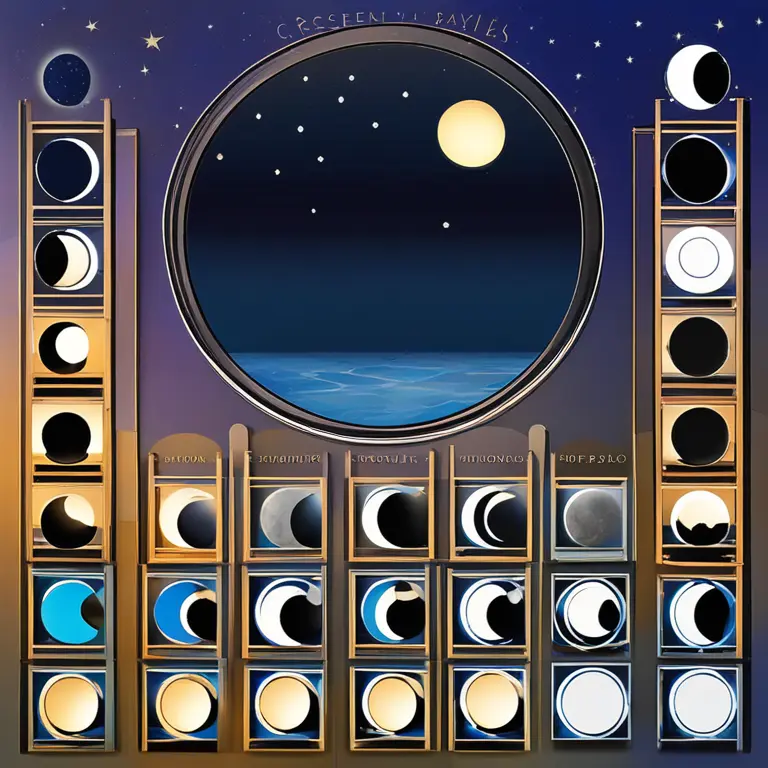
The Mystique of Moon Phases: Celestial Facts
Delve into the celestial facts about moon phases and their intriguing role in astrology and everyday life.
article by Priya Deshmukh
Introduction to Lunar Cycles
The Moon is Earth’s only natural satellite and performs an enthralling celestial dance that captivates onlookers. Governed by the interplay of the Earth, Moon, and Sun, lunar phases have long been shrouded in mystery and wonder. Each phase—new moon, waxing crescent, first quarter, waxing gibbous, full moon, waning gibbous, third quarter, and waning crescent—reflects varying degrees of illuminated surface as seen from Earth. Taking about 29.5 days to transition through all phases, the lunar cycle wields significant influence in various cultural practices and astrological beliefs.

The New Moon's Fresh Beginnings
The new moon marks the beginning of the lunar cycle, often invisible to the naked eye, it represents a clean slate. Astrologically, the new moon in 2024 and beyond is tied to new beginnings, setting intentions, and planting seeds for future ventures. Each zodiac sign experiences the revitalizing energy of the new moon differently, nudging individuals to initiate personal goals or projects. The darkness of the new moon symbolizes potential waiting just beneath the surface, ready to burgeon.

Waxing Moon and Growing Aspirations
Following the new moon, the waxing crescent and first quarter mark periods of visible growth. The crescent glows with hints of progress and expanding awareness, while the first quarter, sometimes called a half-moon, signals a time to overcome challenges. Astrologically, the waxing period in 2024 suggests a time to act on intentions, especially as we harness the increased momentum towards the waxing gibbous phase, culminating in resolve prior to the full moon.

Full Moon: The Pinnacle of Clarity
When the Moon reaches its full phase, its face is entirely illuminated by the Sun’s light. This monthly climax holds significant prominence in astrology. In 2024, the full moon will continue to symbolize a time of fulfillment, completion, and heightened emotions. Astrological interpretations often link the full moon to a moment of revelation or culmination, where the fruits of the intentions set during the new moon may come to light.

Waning Moon and Introspection
As the full moon wanes, entering the gibbous and third quarter phases, the energy shifts from external accomplishment to internal reflection. The waning gibbous phase encourages gratitude, while the third quarter, or last quarter moon, heralds release and forgiveness. Astrology emphasizes the importance of letting go of what no longer serves, allowing individuals to clear the path for the following new moon's arrivals.
Dark Moon: Preparing for Renewal
The final stage of the lunar cycle, the waning crescent, is often referred to as the dark moon. Not to be confused with the new moon, this phase signifies a period of rest, reflection, and preparation for rebirth. Astrologically, the dark moon asks us to surrender to the cycle's ending in 2024 and subsequent years, to reflect on our journey, and prepare to embrace the opportunities the next new moon will usher in.
Scientific Influence and Lore
Beyond astrological influence, moon phases affect Earth's natural rhythms, such as tides and animal behavior. The gravitational pull during various lunar stages can create spring tides or neap tides. Historically, moon phases have been a beacon for farmers and fishers, guiding agricultural activities and fishing periods. Cultural lore gives each full moon a unique name, like the 'Harvest Moon', adding a rich narrative layer to the ever-present celestial neighbor.
Published: 1/19/2024
Modified: 1/19/2024
More predictions
Come back here soon to learn more about yourself and your future


The Tarot Fool: A Journey of Potential & Beginnings
Delve into the symbolism of The Fool in tarot, revealing insights into new beginnings, potential, and the adventurous spirit of this enigmatic card.


Tarot Card Meanings: Insights & Symbols Revealed
Embark on a journey through the tarot to discover the rich symbolism and insights each card holds for your life path and decisions.


The Essentials of Tarot Elements
Discover the significance of the four classic elements within tarot to enrich your readings and personal insights.